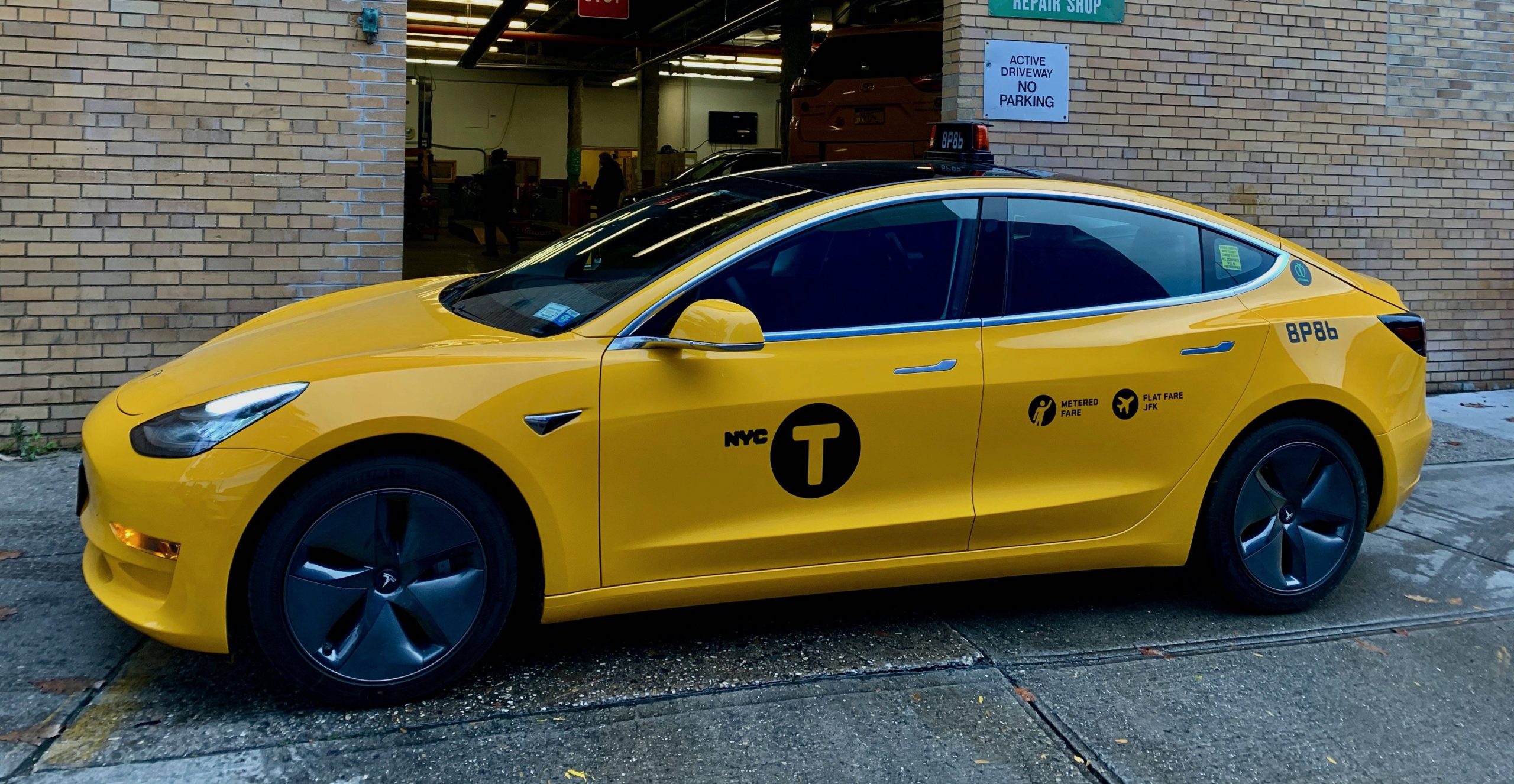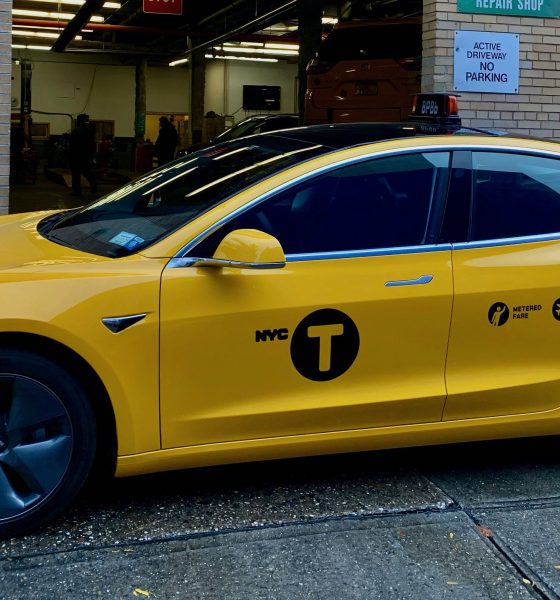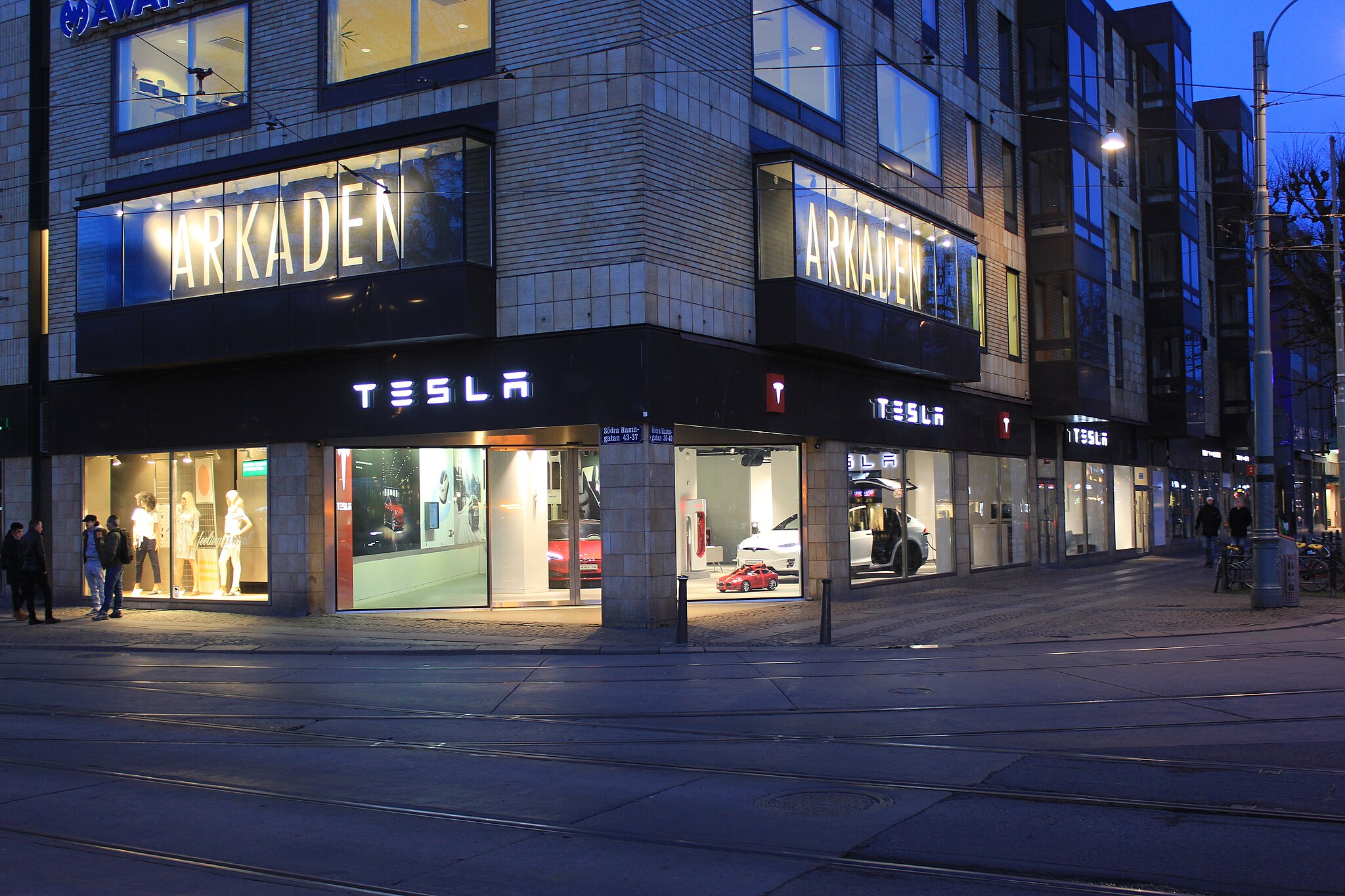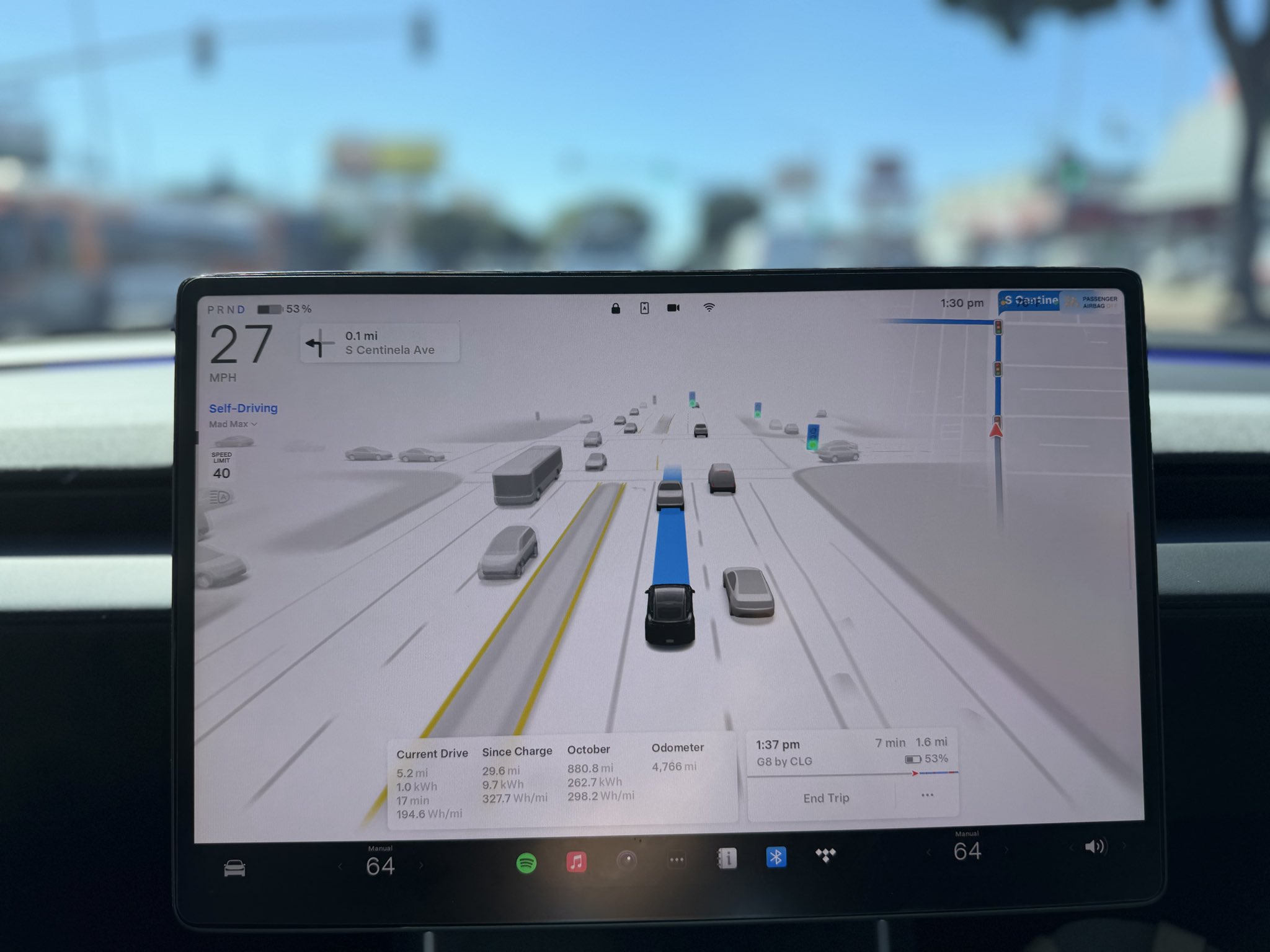

News
Tesla Model 3 wins hearts as famed NYC Taxi, picks up where Nissan Leaf couldn’t
Images of a Tesla Model 3 being used as a New York City taxi cab, complete with the fleet’s iconic yellow paint scheme, have started making the rounds online. The vehicle, which was sighted in Manhattan near a Tesla store, signifies what could very well be an upcoming shift towards sustainability for NYC’s taxi fleet. It also symbolizes a second chance of sorts for all-electric vehicles, especially considering the failure of the Nissan Leaf taxis in previous years.
Back in 2013, New York City launched a pilot program for all-electric taxis with a fleet of six first-gen Nissan Leafs. The vehicles were let loose in the city on Earth Day to much optimism and acclaim, but by 2015, the Leafs were decommissioned. In its final report, the NYC Taxi & Limousine Commission noted that the Nissan Leaf required drivers to significantly alter their driving habits due to the vehicles’ EPA-estimated 84-mile range. This handicap was highlighted further when the weather was hot, since the use of air conditioners was required for NYC taxis.
First Model 3 Taxi in NYC from r/teslamotors
The failure of the Leaf as a New York taxi was a cloud above all-electric cars until 2019, when reports emerged stating that the Tesla Model 3 had been approved for taxi service in the city. The all-electric sedan more than meets the minimum requirements for NYC cabs. These requirements include ample interior space, air conditioning for rear-seat passengers, seats that are easy to clean, and enough cabin space to install the clear partition that separates the driver from passengers in the backseat.
More importantly, the Model 3 does not have the same weakness as the first-gen Leafs from 2013. Unlike the 84-mile Leaf, the shortest-range Model 3 boasts at least 220 miles per charge, and that’s if customers specifically request for the non-Autopilot Standard Range version. Otherwise, the Standard Range Plus, the more affordable variant that could be ordered directly on Tesla’s website, offers an EPA-estimated range of 263 miles for $37,990. Autopilot also comes as a standard feature on variants from the Standard Range Plus and above.
Considering the power and range of the Tesla Model 3, there seems to be a good chance that the vehicle will not have the same feedback from taxi drivers as the first-gen Leafs from 2013. The Model 3, if any, would likely outperform the city’s other, conventional taxis, and its fast-charging capabilities through Tesla’s Supercharger Network would allow the vehicle to replenish most of its range while drivers take a brief break. The vehicle’s sizable cargo space from its trunk and frunk would likely be appreciated by commuters as well.
New York’s Tesla Model 3 taxi drivers would best be advised to take it easy on the all-electric sedan’s accelerator, however. Electric cars are famed for their instant torque, and the Model 3 is no exception, with even the Standard Range Plus variant having a 0-60 mph time that rivals muscle cars. If NYC taxi drivers develop a habit of punching the Model 3’s accelerator at every chance, history might end up repeating itself innumerable times. The first speeding infraction ever committed in the United States back in 1899, after all, was from a New York City cabbie who was driving 12 mph down Lexington Street in Manhattan, 4 mph above the legal speed limit at the time.
The NYC taxi driver, Jacob German, was driving a battery-electric car.

News
Tesla FSD Supervised ride-alongs in Europe begin in Italy, France, and Germany
The program allows the public to hop in as a non-driving observer to witness FSD navigate urban streets firsthand.

Tesla has kicked off passenger ride-alongs for Full Self-Driving (Supervised) in Italy, France and Germany. The program allows the public to hop in as a non-driving observer to witness FSD navigate urban streets firsthand.
The program, detailed on Tesla’s event pages, arrives ahead of a potential early 2026 Dutch regulatory approval that could unlock a potential EU-wide rollout for FSD.
Hands-Off Demos
Tesla’s ride-along invites participants to “ride along in the passenger seat to experience how it handles real-world traffic & the most stressful parts of daily driving, making the roads safer for all,” as per the company’s announcement on X through its official Tesla Europe & Middle East account.
Sign-ups via localized pages offer free slots through December, with Tesla teams piloting vehicles through city streets, roundabouts and highways.
“Be one of the first to experience Full Self-Driving (Supervised) from the passenger seat. Our team will take you along as a passenger and show you how Full Self-Driving (Supervised) works under real-world road conditions,” Tesla wrote. “Discover how it reacts to live traffic and masters the most stressful parts of driving to make the roads safer for you and others. Come join us to learn how we are moving closer to a fully autonomous future.”
Building trust towards an FSD Unsupervised rollout
Tesla’s FSD (Supervised) ride-alongs could be an effective tool to build trust and get regular car buyers and commuters used to the idea of vehicles driving themselves. By seating riders shotgun, Tesla could provide participants with a front row seat to the bleeding edge of consumer-grade driverless systems.
FSD (Supervised) has already been rolled out to several countries, such as the United States, Canada, Australia, New Zealand, and partially in China. So far, FSD (Supervised) has been received positively by drivers, as it really makes driving tasks and long trips significantly easier and more pleasant.
FSD is a key safety feature as well, which became all too evident when a Tesla driving on FSD was hit by what seemed to be a meteorite in Australia. The vehicle moved safely despite the impact, though the same would likely not be true had the car been driven manually.
News
Swedish union rep pissed that Tesla is working around a postal blockade they started
Tesla Sweden is now using dozens of private residences as a way to obtain license plates for its vehicles.

Two years into their postal blockade, Swedish unions are outraged that Tesla is still able to provide its customers’ vehicles with valid plates through various clever workarounds.
Seko chairman Gabriella Lavecchia called it “embarrassing” that the world’s largest EV maker, owned by CEO Elon Musk, refuses to simply roll over and accept the unions’ demands.
Unions shocked Tesla won’t just roll over and surrender
The postal unions’ blockade began in November 2023 when Seko and IF Metall-linked unions stopped all mail to Tesla sites to force a collective agreement. License plates for Tesla vehicles instantly became the perfect pressure point, as noted in a Dagens Arbete report.
Tesla responded by implementing initiatives to work around the blockades. A recent investigation from Arbetet revealed that Tesla Sweden is now using dozens of private residences, including one employee’s parents’ house in Trångsund and a customer-relations staffer’s home in Vårby, as a way to obtain license plates for its vehicles.
Seko chairman Gabriella Lavecchia is not pleased that Tesla Sweden is working around the unions’ efforts yet again. “It is embarrassing that one of the world’s largest car companies, owned by one of the world’s richest people, has sunk this low,” she told the outlet. “Unfortunately, it is completely frivolous that such a large company conducts business in this way.”
Two years on and plates are still being received
The Swedish Transport Agency has confirmed Tesla is still using several different workarounds to overcome the unions’ blockades.
As noted by DA, Tesla Sweden previously used different addresses to receive its license plates. At one point, the electric vehicle maker used addresses for car care shops. Tesla Sweden reportedly used this strategy in Östermalm in Stockholm, as well as in Norrköping and Gothenburg.
Another strategy that Tesla Sweden reportedly implemented involved replacement plates being ordered by private individuals when vehicles change hands from Tesla to car buyers. There have also been cases where the police have reportedly issued temporary plates to Tesla vehicles.
News
Czech Deputy excited for Tesla FSD, hints at Transport Committee review
The ANO party lawmaker shared his thoughts about FSD in a post on social media platform X.

Martin Kolovratník, a Czech Republic Chamber of Deputies member, has expressed his excitement for Tesla’s Full Self-Driving (FSD) after an apparent constituent called for a quick approval for the advanced safety system.
The ANO party lawmaker, who drives both diesel and EV, shared his thoughts about the matter in a post on social media platform X.
The official’s initial statements
Kolovratník kicked off the exchange with a post outlining his coalition’s efforts to scrap highway toll exemptions for electric vehicles and plug-ins starting in 2027.
“Times have changed. Electric vehicles are no longer a fringe technology, but a full-fledged part of operations. And if someone uses the highway network, they should follow the same rules as everyone else. That’s the basis of fairness,” he wrote.
He emphasized equity over ideology, noting his personal mix of diesel and electric driving. “For this reason, there is no reason to continue favoring one technology at the expense of another… It’s not about ideology, it’s about equal conditions. That’s why we clearly agreed within the new coalition: the exemption for electric vehicles and plug-ins will end in 2027. The decision is predictable, understandable, and economically sound.”
Tesla FSD enthusiasm
The conversation pivoted to Tesla’s FSD when X user @robotinreallife, who seems to be one of the official’s constituents, replied that other matters are more important than ending highway exemptions for EVs.
“I’m happy to pay for the highway, but I have a question about a much more fundamental matter: The Netherlands will approve the operation of Tesla FSD in February 26, a technology that has been proven to reduce accidents. The Czech Republic has the option to immediately recognize this certification. Do you plan to support this step so that we don’t unnecessarily delay?” the X user asked.
Kolovratník responded promptly, sharing his own excitement for the upcoming rollout of FSD. “I know about it. I like it and it seems interesting to me. Once we set up the committees and subcommittees, we’ll open it right away in that transport one. Thanks for the tip, I’ll deliver the report,” the official noted in his reply on X.
Kolovratník’s nod to FSD hints at the system’s potentially smooth rollout to Czechia in the coming year. With the Netherlands possibly greenlighting FSD (Supervised) in early 2026, Kolovratník’s commitment could accelerate cross-border certification, boosting FSD’s foray into Europe by a notable margin.









